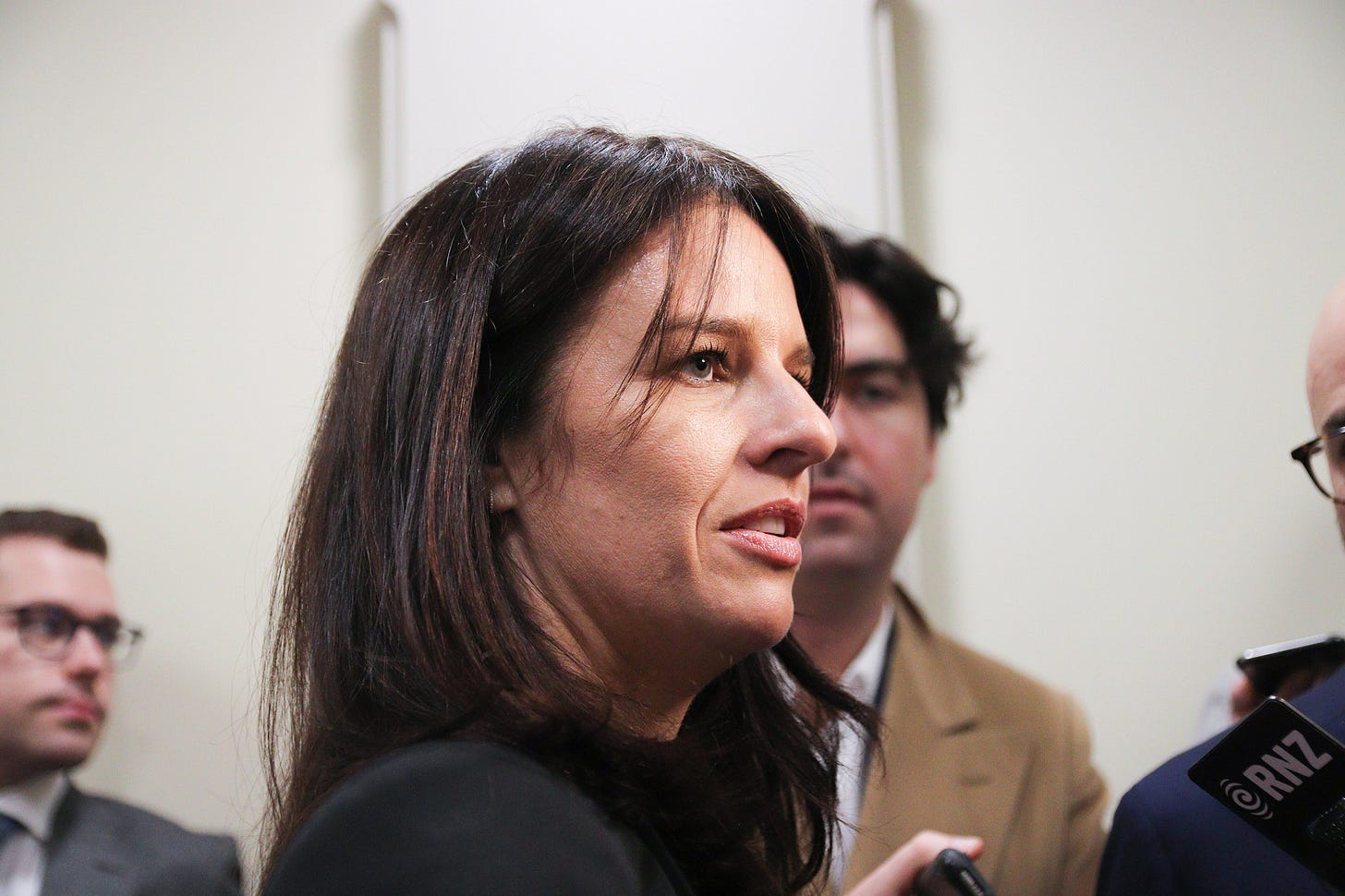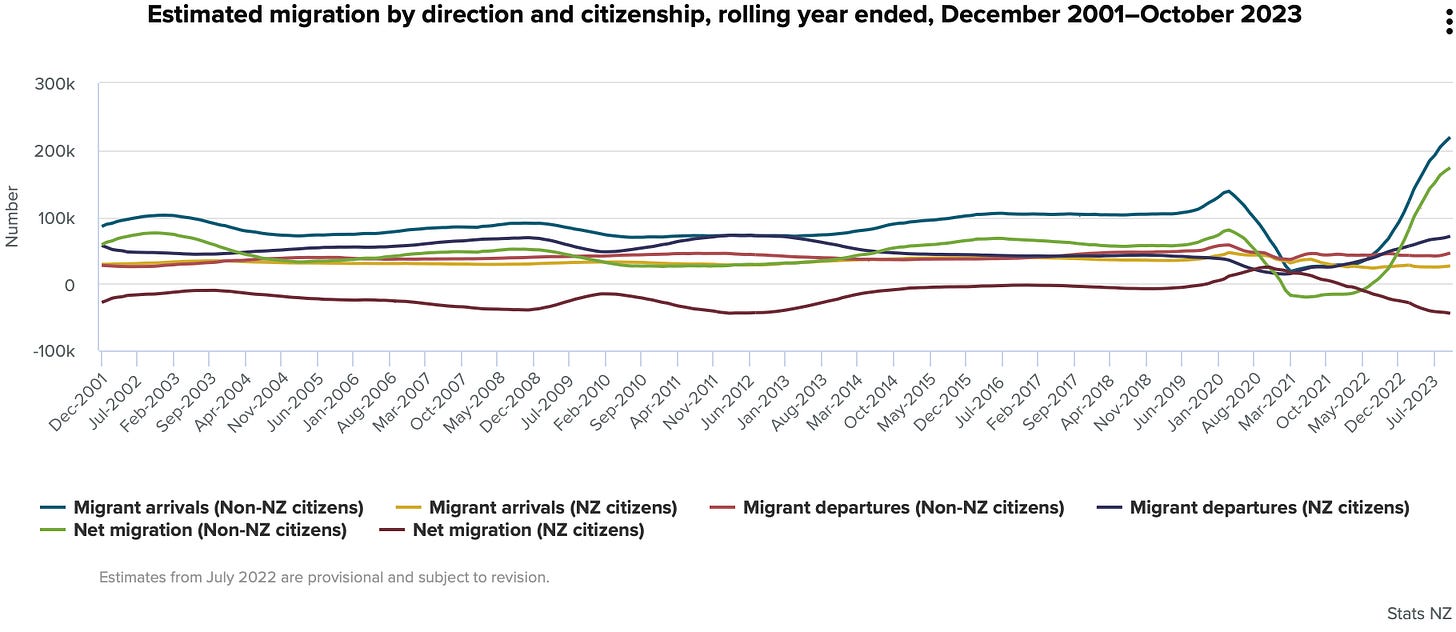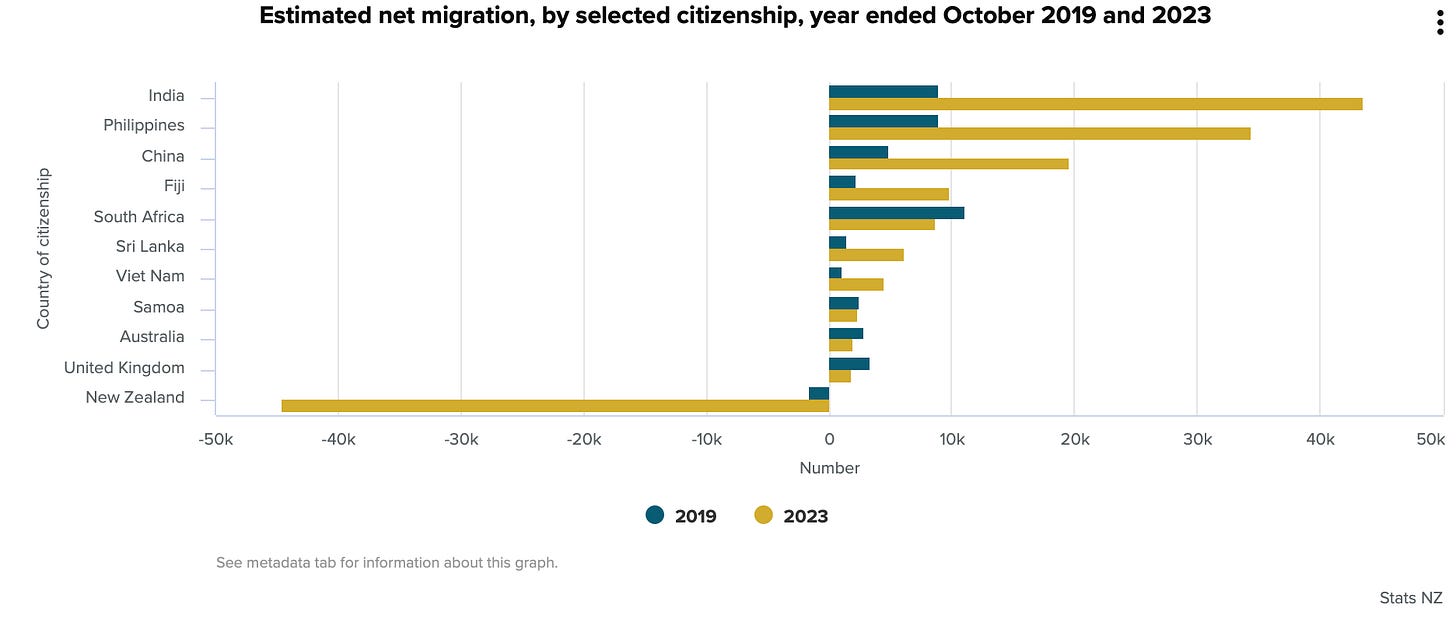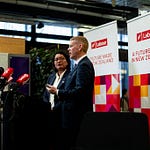
TL;DR: Net migration hit a record high 128,900 in the year to October, which the new Government has decided is “unsustainable” and requires a review of settings to ensure it is “balanced” with the economy’s skills needs and infrastructure capacity.
However, new PM Christopher Luxon has stopped short of a full strategic review of our immigration policies, suggesting tweaks in the short term would be enough and that more formal targets were not either possible or desirable. His views this week were contrast with his calls in September and May this year for looser settings to bring in more workers at lower wages.
News elsewhere this morning:
The Climate Commission last night released its latest advice to the new Government on meeting legislated emissions reductions budgets, recommending an acceleration of measures to reduce industrial, transport and farming emissions in a way that saves $2 billion by 2040, including by redesigning the Emissions Trading Scheme to stop giving freebies to industrial exporters and pricing farm emissions; RNZ Eloise Gibson, NZ Herald Jamie Morton, Stuff Olivia Wannan & Newsroom Marc Daalder
Parliament went into urgency last night to force through the Reserve Bank of New Zealand (Economic Objective) Amendment Bill, the Fair Pay Agreements Act Repeal Bill and the Land Transport (Clean Vehicle Discount Scheme Repeal) Amendment Bill to repeal various measures before Christmas without fresh regulatory or economic assessments; and,
Talks at COP 28 are dragging into overtime this morning, although it appears a battle to get oil and gas producing countries to commit to slashing fossil fuel use has failed, with the ‘phasing out or phasing down’ phrase replaced by ‘reducing emissions’ in a draft final statement.
Usually at this point in the edition, there’s a paywall that only paying subscribers can see below and hear more detail and analysis in the podcast above. But we’d love you to join the community of paying subscribers, who can read and comment on everything inside the paywall all the time and get access to our weekly ‘Hoon’ webinar on the news of the week on Thursday’s at 5pm here via YouTubeLive for an hour. The 50%-off offer is open to new subscribers until December 21. I also invite paying subscribers to again vote in our poll below on whether we should open up all our articles immediately to everyone until Gravy Day.
And here’s a repeat of our special, special offer for under 30s.
National now says it wants tighter migration settings
Just as fresh figures arrive to confirm record-high inflows and outflows of temporary workers and citizens respectively in the year to the end of October, the new Government has decided to reverse its pre-election preference for looser migration settings.
Hard on the heels of an Australian decision on Monday to halve its migrant intake, PM Christopher Luxon told his post-Cabinet news conference that annual net migration of over 118,000 for the year to September was “unsustainable” and he had asked Immigration Minister Erica Stanford to review those settings to find a better “balance” with unmet skills shortages and infrastructure.
However, he has stopped short of nominating a ‘sweet spot’ for migration levels.
Here’s his key comments (bolding mine):
“We’ve gone through a period where we had the borders shut down. We had very restrictive immigration that was actually too tight, and too choked for too long. Then it was released very, very quickly, with not enough checks and balances in place, and, as a result, we’ve ended up with 118,000 net migration.
“Now, we want immigration to this country. We want the best and the brightest to be able to come here. We want skilled workers to come here, but we’ve got to make sure that that is linked up to an economic agenda where we have genuine skill shortages. All we’re asking for in the conversations the Immigration Minister will be having with Immigration New Zealand are about making sure that we actually have some rigour in the application of inviting migrants into this country.” PM Christopher Luxon via the transcript of his post-cabinet news conference.
This exchange illustrated the lack of detail or longer-term view in this change of position, Again, the bolding is mine:
Media Question: Both the Infrastructure and the Productivity Commissions have previously asked to the long-term population plan, saying that migration’s hard to predict; it’s hard to plan for, basically. I know you share that frustration. You say the settings have been swapping around—we had not enough; now we have too much. Would you be interested in creating a long-term population plan that actually sets targets and potentially even caps on migration? Is that something you’d look into?
PM Luxon: It's often a really attractive place to go to, to actually put a number on it and what is the ideal level of net migration. But, actually, no Government has been able to do that or can realistically do that, because with our economic cycles being quite variable, the skill shortages that we need—it’s a very dynamic sort of set up.
All I’m foreshadowing to you is that, actually, the current levels of 118,000 net migration are not sustainable for New Zealand in the long term. We have to work harder at getting people off welfare into work and using the 60,000 people that actually want to work, and should be working, working, and we should make sure that migration is very, very tightly linked to our economic agenda and, actually, the vacancies that we have and the gaps that we have, and then we should be out in the world very aggressively and positively attracting that talent to choose to come to New Zealand; not go to Canada or not go to Australia as a result.
“So, I appreciate it. All I’m saying is you’ve got to triangulate ultimately a level of migration with a level of infrastructure support and development as well as, obviously, the economic agenda.
‘This is now. That was then.’
The change in view and tone is remarkable in just a few months.
Here’s Luxon announcing National’s policy of increasing the working holiday age to 35 from 30 and allowing migrants to re-apply for these visas three times. working on September 7th, which was the last month of that year to September with the net migration of 118,000:
"Migration does have huge tax benefits for us. It does have economic multiplier effects." Luxon via Newshub in this article titled: “National vows to boost immigration to help New Zealand economy.”
“We will also scrap the median wage requirements and let businesses and sectors like tourism attract the staff they need at rates that reflect their skills and experience." Luxon via Crux
All of those policies are aimed at increasing numbers of lower-skilled migrant workers on temporary work visas.
Luxon was also keen on increasing migrant worker numbers in April in this piece on Newshub titled: Luxon says migrants will be key to filling critical staff shortages.
"We are a party that really believes in immigration. We think that migrants have a huge value and a lot of contribution to make to New Zealand.
"Across all sectors of New Zealand we are short of workers at the moment. We have sent a message to the world that we are fundamentally closed for business. If you're a migrant coming to New Zealand, you might be a nurse or a doctor, there is currently no pathway to residency.
"If we want to attract the best we have to be the best in terms of an immigration system and an Immigration New Zealand response and we're not at the moment."
"We've got to do a much better job of making a much more competitive offer for working travellers… that want to come here and work in kiwifruit [picking] or tourism. We should be out there promoting New Zealand.
"We need to waive the fees, we need to extend the age, if you've been here once you can come back a second or third time. The same thing needs to happen, if you think about our healthcare workforce we haven't been approving those people and actually getting them here." Luxon via Newshub on April 13.
Stanford was similarly bullish about encouraging more migrant workers to come in this August 19, 2022 statement:
“Wednesday’s Monetary Policy Statement from the Reserve Bank confirmed that labour shortages are the worst they have been in 50 years. It said that the inflationary consequences of labour shortages are even worse than in May when the border was largely closed.
“This is a damning indictment of the Labour Government’s failure to deliver the critical workers needed. Kiwis will feel the brunt of this failure, with higher prices forecasted to persist for longer.
“Labour’s immigration policies have been a disaster. Just five per cent of the 20,000 workers promised in March have arrived, and only 442 Accredited Employer Work Visa applications have been submitted in five weeks despite Immigration New Zealand forecasting 3,500 per month.
“This Labour Government has turned New Zealand into an undesirable destination for migrants. Why would a skilled migrant choose New Zealand in 2022 compared to what Australia can offer?
The Government’s immigration policies have been a total disaster, and Kiwis are paying the price. Labour shortages will drag on for longer, putting more pressure on businesses and stoking inflation across the economy.” Stanford statement on August 19, 2022
Stanford was quoted yesterday as asking officials for ways to tighten settings.
“Immigration NZ has been doing a lot recently because of the issues around migrant exploitation, so they've already pulled a lot of levers.
“But there are a couple more things that I've asked for them to provide advice on where I think they could do more.” Stanford via The Post-$$$
After the deluge
Net migration has been slowing somewhat in recent months, but the annual figures have been getting larger, due to revisions higher for previous months.
Stats NZ reported yesterday there were a record-high 245,600 migrant arrivals in the year to the end of October, up 165% on the previous year and more than double the average for the years from 2002 to 2019. There were 116,700 migrant departures, up 26% on the previous year. That left net migration of 128,900, also a record high.
There was also a record-high net migration gain of 173,400 non-New Zealand citizens, more than double the previous record and triple the average from 2002 to 2019.
The net migration loss of 44,500 New Zealand citizens in the October 2023 year was also a new annual record, just beating the 44,400 lost in the February 2012 year. It was almost double the 25,200 average from 2002 to 2014 and ten times the average loss from 2015 to 2019
.
There have been 24 consecutive months of net migration losses of New Zealand citizens to October 2023, amounting to 67,000. This followed 27 months of net migration gains of New Zealand citizens totalling 32,100. About half of the net losses of New Zealand citizens are to Australia.
So what should National be doing?
A proper migration review would take a long-term view about population growth. Currently, the planning arms of Government use Stats NZ’s projections to 2073, which are for net migration averaging 25,000 each year to generate 0.5% population growth.
In reality, we have overshot Stats NZ’s forecasts for 20 years, largely because settings have been loosened repeatedly by both Labour and National to juice GDP growth and budget surpluses for tactical reasons. But five or six tactical actions have turned into a long-term accidentally-on-purpose strategy of population growth of 1.5% to 2.0% per annum, but without the infrastructure investment or the clear permission of voters.
Luxon’s tactical review doesn’t address this lead for a longer-term and joined-up approach on population growth and infrastructure. Remembering that 1.5% to 2.0% per annum growth for the next 50 years would mean New Zealand’s population would grow to 17 million to 20 million by 2100.
A proper review and debate would force both major parties and voters to own up to a fast population growth strategy that matched up with much higher investment, debt and congestion charges to pay for much, much more infrastructure.
That’s the bottom line here. Choosing not to have the debate allows both major parties and median voters to continue their self-delusions that they can have it all: fast population and nominal GDP growth that generates fast-rising land prices, low public debt, lower wage growth and lower mortgage rates, but without the higher taxes, congestion and water charges and higher public debt that comes with much, much more investment.
It is the definition of magical thinking.
Cheers
Bernard















